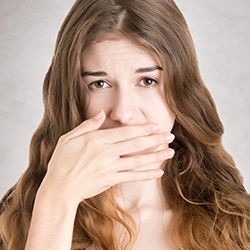
The Causes of Bad Breath
 Bad breath, or halitosis, can be an annoying condition and originates from multiple sources. The typical causes of bad breath usually stem from an obvious source, the oral cavity. However, the respiratory and gastrointestinal systems can contribute to bad breath as well. For example, sinus, lower respiratory, and tonsillar infections, as well as certain gastrointestinal diseases, can result in bad breath. This article will focus primarily on the oral causes of bad breath and how to control it. Naturally occurring bacteria, periodontal health, oral hygiene, and an individual’s dietary habits can all contribute to this embarrassing problem.
Bad breath, or halitosis, can be an annoying condition and originates from multiple sources. The typical causes of bad breath usually stem from an obvious source, the oral cavity. However, the respiratory and gastrointestinal systems can contribute to bad breath as well. For example, sinus, lower respiratory, and tonsillar infections, as well as certain gastrointestinal diseases, can result in bad breath. This article will focus primarily on the oral causes of bad breath and how to control it. Naturally occurring bacteria, periodontal health, oral hygiene, and an individual’s dietary habits can all contribute to this embarrassing problem.
The mouth is home to numerous kinds of bacteria. These bacteria give off sulfur compounds as they break down food particles and excrete waste. This metabolism of carbohydrates leads to a condition known as halitosis, or bad breath.
In a healthy oral environment, when a patient practices good oral hygiene (which consists of regular brushing, flossing, and the use of a mouth rinse), the numbers of these naturally occurring bacteria are kept in check. However, when one neglects their oral hygiene, it can result in an increase in the number and types of bacteria that can cause bad breath and harm the overall periodontal health of a patient.
Poor periodontal health typically coincides with bad breath. Periodontal disease can be characterized by red, swollen, inflamed, or receding gum tissues, deep periodontal pockets, and a loss of bony support around the teeth that may result in premature tooth loss. Periodontal disease, or gum disease, is caused by bacteria that can be found in your mouth. These bacteria, when they are not disrupted, proliferate and form compounds that are more dangerous for your gums and teeth. Good oral hygiene reduces the number and types of these harmful bacteria.
Another cause of bad breath is an individual’s dietary habits. A diet that is high in foods with pungent odors will increase bad breath. Examples of these types of foods include garlic and onions. Tobacco products, either smokeless or not, and alcohol can also contribute to bad breath.
As one can see, there is a direct cause and effect relationship between the amount of bacteria present in your mouth with gum disease and bad breath. Getting rid of bad breath requires consistent oral hygiene. An acceptable oral hygiene routine should consist of three items: (1) Brushing two or three times a day for at least two minutes each. (2) Flossing once or twice a day. Flossing helps disrupt the bacterial complexes that form between your teeth (brushing alone cannot do this). (3) Rinse with an antiseptic mouthwash once or twice a day. There are new non-alcoholic rinses on the market that are good for this. “Listerine Zero” is an example.
Following these guidelines for oral hygiene combined with regular checkups at Greenwood Dental will lead to good periodontal health and will help cure bad breath.